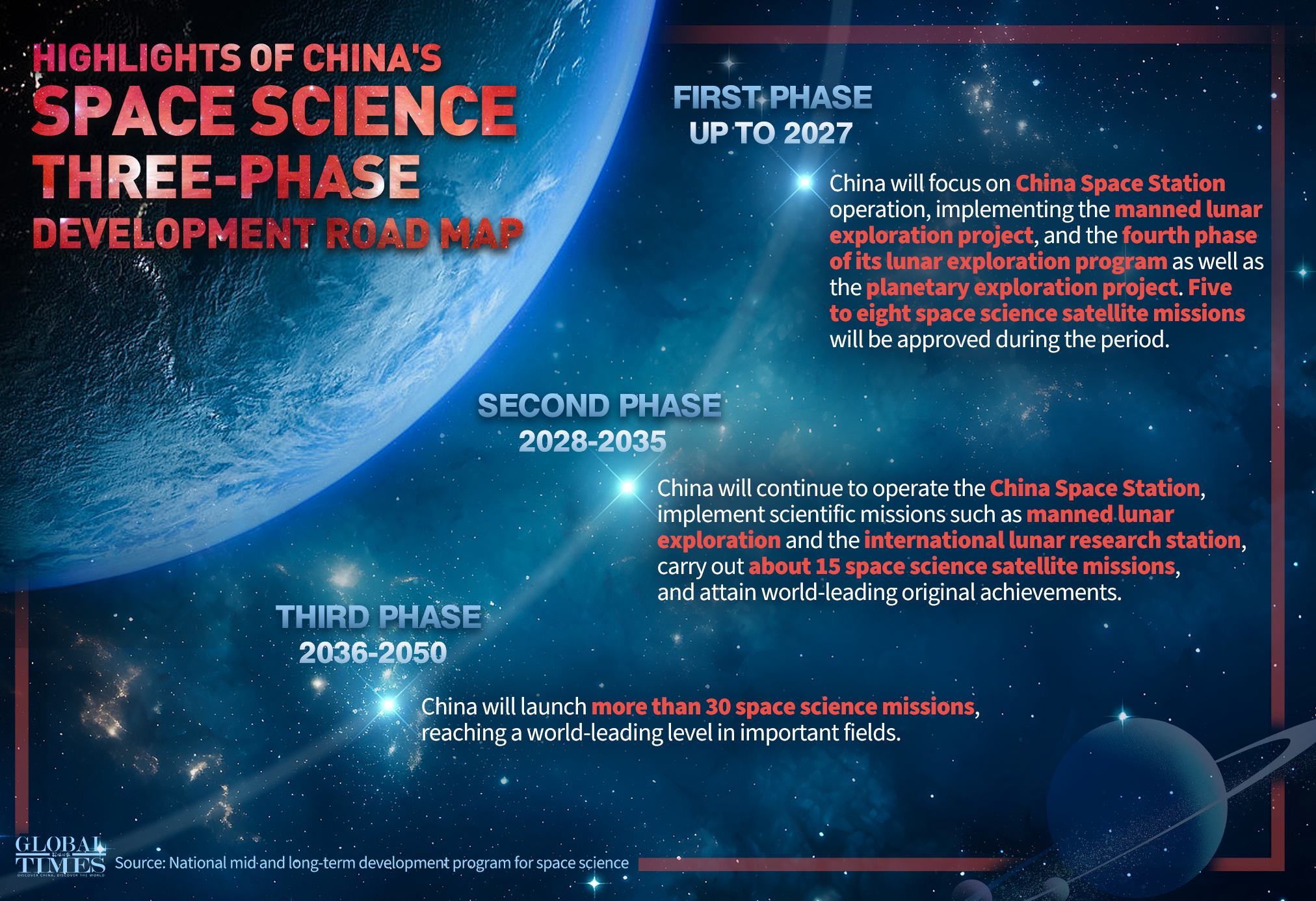
Highlights of China's space science three-phase development road map. Graphic: GT
China unveiled on Tuesday its first-ever national-level development program for medium- to long-term space science, which will guide the country's planning of space science missions and space research from 2024 to 2050, including conducting manned lunar exploration by 2027. The plan also establishes the clear goal of building China into a world space science power by 2050.
The program, jointly released by the Chinese Academy of Sciences (CAS), the China National Space Administration (CNSA) and the China Manned Space Agency (CMSA), aims to "achieve high-quality development in space science, drive breakthroughs in space technology innovation, upgrade space applications, rank among the world's leading space nations, and establish China as a global leader in space science," the CAS said in a statement it provided to the Global Times on Tuesday.
The CAS also highlighted in the statement that the implementation of the program is expected to accelerate revolutionary breakthroughs in basic scientific research in China's space science field, enable the country to attain major world-class scientific achievements early, drive next-generation advancements in space technology, and promote high-quality development of space applications.
The program will also provide strong support for building a community with a shared future for humanity in outer space and help establish China as a global powerhouse in space exploration and science and technology, reads the CAS statement.
The program outlines the country's space science development in three stages.
By 2027, China, with the aim of achieving several original results with significant international impact, will continue to operate the China Space Station, advance planetary exploration missions and implement the fourth phase of its lunar exploration projects. The country's first-ever manned lunar exploration is also scheduled to take place during the pre-2027 period.
Lin Xiqiang, a CMSA spokesperson, said on Tuesday at a press conference on the program that "manned lunar exploration is a strategic endeavor that promotes the progress of human civilization and demonstrates the responsibility of a major power."
China's first lunar landing aims to leverage the unique advantages of taikonauts conducting exploration activities on the lunar surface, offering a broader historical opportunity for China's extraterrestrial exploration, the CMSA official said.
"We have planned scientific objectives in three major areas: lunar science, moon-based science, and resource exploration and utilization, covering nine key directions," Lin noted.
On the second stage from 2028 to 2035, China aims to achieve original world-leading scientific results through the implementation of the first-phase missions. Continuing operating the China Space Station, and demonstrating and implementing manned lunar exploration, the International Lunar Research Station (ILRS), solar system boundary exploration, giant planet system exploration, and Venus atmospheric sampling return missions, are also on schedule.
Yang Xiaoyu, director of CNSA's system engineering department, disclosed on Tuesday that the ILRS has achieved extensive results in international cooperation.
"We have signed agreements with 17 countries and international organizations and are prepared to offer collaboration opportunities at multiple levels and in various forms to our international partners,'' he said. "We will work with our partners on joint demonstration of overall mission plans, joint design of the International Lunar Research Station, technical cooperation on projects, implementation of overall mission planning, and the sharing of scientific data."
During this phase, five to six major missions will be implemented, along with around 25 medium-to-small scale and opportunity-based missions.
And by the third stage from 2036 to 2050, China's key areas of space science will reach world-leading levels. During this period, five to six major missions will be implemented, along with around 25 medium-to-small scale and opportunity-based missions.
China will also carry out space science research and development under five scientific themes of extreme universe, ripples in spacetime, panorama of the Sun-Earth System, habitable planets and exploring the laws of space.
Zhang Shuangnan, a senior professor with the Institute of High Energy Physics, CAS and principal investigator of the institute's Gamma-ray Burst Polarimeter - POLAR project, told the Global Times on Tuesday that he has been involved in the strategic research and preparation for the release of this program. "We believe that one of the hallmarks of a space power is it being a strong power in space science."




